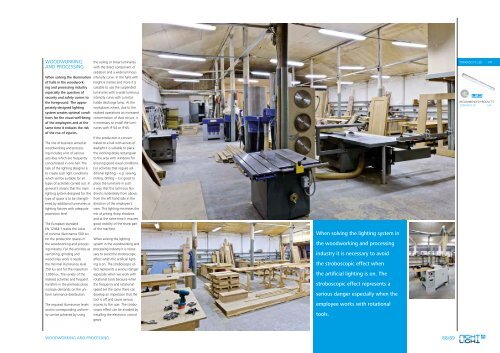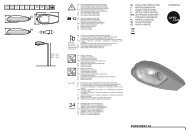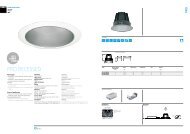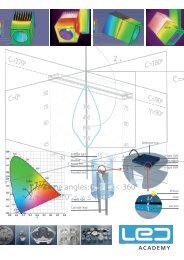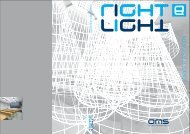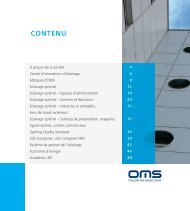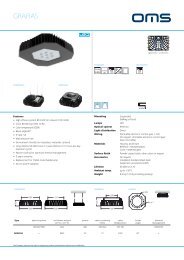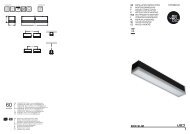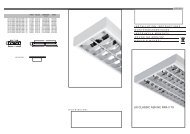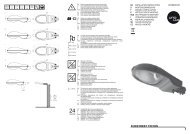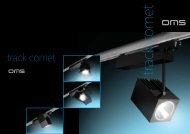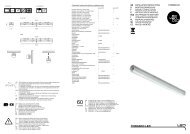Download PDF Catalogue - OMS lighting
Download PDF Catalogue - OMS lighting
Download PDF Catalogue - OMS lighting
Create successful ePaper yourself
Turn your PDF publications into a flip-book with our unique Google optimized e-Paper software.
WOOdwORKING<br />
AND PROCESSING<br />
When solving the illumination<br />
of halls in the woodworking<br />
and processing industry<br />
especially the question of<br />
security and safety comes to<br />
the foreground. The appropriately<br />
designed <strong>lighting</strong><br />
system creates optimal conditions<br />
for the visual well-being<br />
of the employees and at the<br />
same time it reduces the risk<br />
of the rise of injuries.<br />
The line of business aimed at<br />
woodworking and processing<br />
includes a lot of various<br />
activities which are frequently<br />
concentrated in one hall. The<br />
task of the <strong>lighting</strong> designer is<br />
to create such light conditions<br />
which will be suitable for all<br />
types of activities carried out. In<br />
general it means that the main<br />
<strong>lighting</strong> system designed for this<br />
type of space is to be strengthened<br />
by additional luminaires or<br />
<strong>lighting</strong> fixtures with adequate<br />
protection level.<br />
The European standard<br />
EN 12464-1 states the value<br />
of minimal illuminance 500 lux<br />
for the production spaces in<br />
the woodworking and processing<br />
industry. For the activities as<br />
varnishing, grinding and<br />
wood inlay work it needs<br />
the minimal illuminance level<br />
750 lux and for the inspection<br />
1,000 lux. The variety of the<br />
realised activities and frequent<br />
transfers in the premises place<br />
increase demands on the uniform<br />
luminance distribution.<br />
The required illuminance levels<br />
and its corresponding uniformity<br />
can be achieved by using<br />
the ceiling or linear luminaires<br />
with the direct component of<br />
radiation and a wide luminous<br />
intensity curve. In the halls with<br />
height 6 metres and more it is<br />
suitable to use the suspended<br />
luminaires with a wide luminous<br />
intensity curve with a metalhalide<br />
discharge lamp. At the<br />
workplaces where, due to the<br />
realised operations an increased<br />
concentration of dust occurs, it<br />
is necessary to install the luminaires<br />
with IP 54 or IP 65.<br />
If the production is concentrated<br />
to a hall with access of<br />
daylight it is suitable to place<br />
the working desks rectangular<br />
to the area with windows for<br />
ensuring good visual conditions.<br />
For activities that require additional<br />
<strong>lighting</strong> – e.g. sawing,<br />
milling, drilling – it is good to<br />
place the luminaire in such<br />
a way that the luminous flux<br />
directs moderately from above,<br />
from the left hand side in the<br />
direction of the employee’s<br />
view. This <strong>lighting</strong> minimises the<br />
risk of arising sharp shadows<br />
and at the same time it ensures<br />
good visibility of the sharp part<br />
of the machine.<br />
When solving the <strong>lighting</strong><br />
system in the woodworking and<br />
processing industry it is necessary<br />
to avoid the stroboscopic<br />
effect when the artificial <strong>lighting</strong><br />
is on. The stroboscopic effect<br />
represents a serious danger<br />
especially when we work with<br />
rotational tools because when<br />
the frequency and rotational<br />
speed are the same there can<br />
develop an impression that the<br />
tool is off and cause serious<br />
injuries to the user. The stroboscopic<br />
effect can be avoided by<br />
installing the electronic control<br />
gears.<br />
When solving the <strong>lighting</strong> system in<br />
the woodworking and processing<br />
industry it is necessary to avoid<br />
the stroboscopic effect when<br />
the artificial <strong>lighting</strong> is on. The<br />
stroboscopic effect represents a<br />
serious danger especially when the<br />
employee works with rotational<br />
tools.<br />
TORNADO PC LED 147<br />
RECOMMENDED PRODUCTS<br />
tornado PC 147<br />
woodworking and processing<br />
88/89


